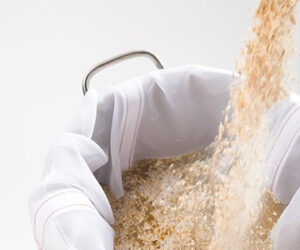American Wheat: Tips from the Pros
Brewer: Doug Rehberg, Widmer Brothers Brewing Co., Portland, OR
American hefeweizens or wheat beers usually carry no clove characteristics and can have low levels of banana and other fruity esters.
American wheat can also run the gambit when it comes to hopping; low to moderate levels of bitterness and aroma, from either American or noble hops.
We use pale two-row barley malt, wheat malt and a touch of Extra Special malt for color in Widmer Hefeweizen. Wheat malt makes up a little less than half of our grain bill. We use a northwest soft white wheat variety called Madsen, which is grown in the Palouse region of Eastern Washington. The barley malt is a blend of three different varieties of two-row, Metcalfe, Kendal and Copeland.
I would recommend a fairly neutral yeast strain in regards to ester and phenol profile for an American wheat. I would keep the temperature of fermentation in the mid to upper 60s Fahrenheit (18 to 20 °C) to dampen ester production. We use Alchemy (hop blends made for Widmer) for bittering, and Cascade and Willamette hops for aroma. We have been playing around with Citra hops. The Citra hop has an amazing grapefruit aroma. I would also consider Chinook
or Crystal.
If you want to make an American wheat at home, there are some other tips to keep in mind. First, use non-flocculent yeast. Second, don’t be afraid to grind the wheat finer than the pale malt. Keep your grain bed shallow for lautering and you should be able get by without rice hulls.
Brewer: Paul Cain, Southern Tier Brewing Company in Lakewood, NY
American brewers have learned to use the American wheat style as somewhat of a platform for innovation. From my experience, the best way to stamp the ol’ Stars-n-Stripes on a beer style is simply go big, go clean and add copious amounts of Washington-grown hops.
Our American wheat consists of Canadian 2-row malted barley base malt, along with 20–50% American soft white winter wheat, and no more than 5% 60 °L caramel malt. Most of your fermentable sugar will come from the base, while the wheat will provide that “bready” flavor and dry texture. The caramel gives the finished beer that moderate malt back to balance everything out a bit.
Most American ale yeast strains should be suitable for brewing American wheat. I typically prefer strains similar to Chico or PacMan, that is to say a strain with a high rate of attenuation, moderate fruity ester production, with the capacity to clean up any diacetyl production.
I love American wheat brewed and dry hopped with a single variety of American hops. Being a true hophead, I use the Southern Tier Hop Sun to showcase one of my all time favorite hops, Centennial. I would recommend using any dual hop with an aroma that you are fond of — dry hop to let those hops shine!
Good sanitation should go without saying. Keep in mind that American wheat is one of the lightest of all ale styles, and any beer spoiling critters are going to be really easy to taste. Use this style to show off your favorite fruit and spice combination, or spotlight your favorite hop.
Brewer: Ashton Lewis, Springfield Brewing Company in Springfield, MO
The primary difference between German weizens and American wheat is the yeast strain used. While Bavarian weizen beer is fermented using an ale strain noted for aromas like banana and clove, American wheat beer is usually fermented with a rather neutral yeast strain. Some brewers use a lager yeast for American wheat, although most consumers assume that all wheat beers are ales. American wheat can also be contrasted to Belgian wit and Berliner Weisse. American wheat has no spices, like Belgian wit beers, and is not sour as is the case with Berliner Weisse.
When I drink our best selling beer, Mueller Wheat, I find that it is extremely refreshing, clean and balanced. To me those are the key attributes of a great American wheat beer. For this style I like a dry beer with a little acidity and a very clean bready aroma flavor from the yeast that remains in the beer.
In order to get the dry, slightly acidic palate we use a blend of 2-row pale malt (50%), malted wheat (40%) and raw wheat (10%). The raw wheat is very easy to use in infusion or step mashes since the starch gelatinizes at normal mash temperatures; in other words boiling is not required to use this adjunct. We use a step mash profile with rests at 50 °C (122 °F), 60 °C (140 °F), 68 °C (154 °F) and a mash-off temperature of 76 °C (169 °F). This givesus very fermentable wort with a gravity of 11.25 °Plato that typically ferments down to 1.8 °Plato.
We use WLP001 from White Labs as our stock ale yeast for most of the ales we brew, including our wheat. I like this strain for several reasons; it ferments reliably, it is very clean, is happy in our brewery and is not too flocculent. Although our wheat is not really turbid it does have a consistent cloud and this yeast helps with the impossible goal of defying gravity. I think other clean strains with medium to high attenuation work well for this beer style.
I don’t like American wheat beers that are over-hopped. We shoot for about 14 IBU using Northern Brewer or Perle for bitterness. I like a subtle hop spiciness to complement the slight acidity of our wheat and we use Hallertau Tradition or Liberty for the second and third hop additions. The result is a balanced bitterness and nice spicy note in the nose.


